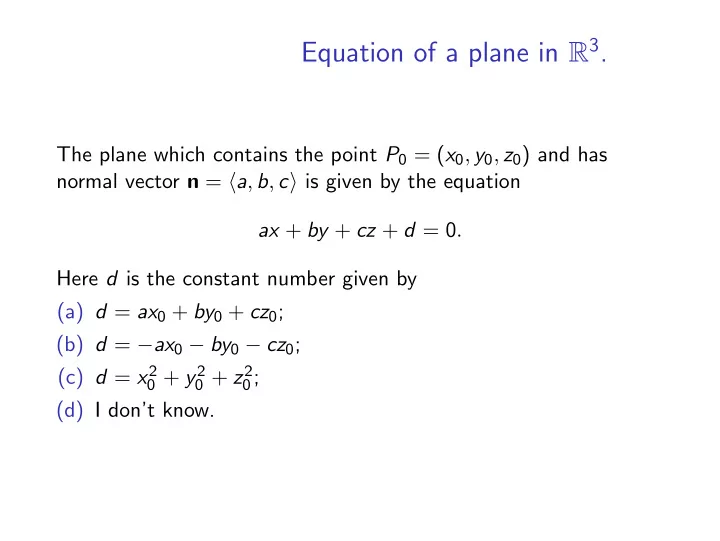

Equation of a plane in R 3 . The plane which contains the point P 0 = ( x 0 , y 0 , z 0 ) and has normal vector n = ⟨ a , b , c ⟩ is given by the equation ax + by + cz + d = 0 . Here d is the constant number given by (a) d = ax 0 + by 0 + cz 0 ; (b) d = − ax 0 − by 0 − cz 0 ; (c) d = x 2 0 + y 2 0 + z 2 0 ; (d) I don’t know.
Intersection of two planes in R 3 . Take two planes in R 3 and intersect them. The set of point in the intersection could form (a) a single point; (b) a line; (c) there could be no points in the intersection; (d) either (b) or (c) could happen. Case (c) happens ⇐ ⇒ the planes are parallel ⇐ ⇒ the normal vectors are parallel. Case (b) happens whenever they aren’t parallel. Then we want to determine the equation of this line.
The Right-Hand Rule Consider the following vectors: b a Then a × b points (a) into the board; (b) out of the board. Note that b × a points into the board.
Cross product: example Take a = ⟨ 1 , 0 , 1 ⟩ , b = ⟨ 4 , 2 , 0 ⟩ . Then ⃒ ⃒ i j k ⃒ ⃒ ⃒ ⃒ a × b = 1 0 1 =? ⃒ ⃒ ⃒ ⃒ 4 2 0 ⃒ ⃒ (a) − 2 i − 4 j + 2 k ; (b) 2 i − 4 j − 2 k ; (c) − 2 i + 4 j + 2 k ; (d) I don’t know.
Properties of the cross product 1 a × b = − b × a ; 2 ( c a ) × b = c ( a × b ) = a × ( c b ); 3 a × ( b + c ) = a × b + a × c ; 4 ( a + b ) × c = a × c + b × c ; 5 a · ( b × c ) = ( a × b ) · c ; 6 a × ( b × c ) = ( a · c ) b − ( a · b ) c .
Two intersecting planes in R 3 Take two planes with equations x + y + z = 1; x − 2 y + 3 z = 1 . They intersect forming a line L . This line will be perpendicular to the normal vectors n 1 = ⟨ 1 , 1 , 1 ⟩ ; n 2 = ⟨ 1 , − 2 , 3 ⟩ , so its direction is the same as that of ⃒ ⃒ i j k ⃒ ⃒ ⃒ ⃒ n 1 × n 2 = 1 1 1 = ⟨ 5 , − 2 , − 3 ⟩ . ⃒ ⃒ ⃒ ⃒ 1 − 2 3 ⃒ ⃒
We can also find a point P in L as follows: let’s look for a point with z = 0. Then the equations become x + y = 1; x − 2 y = 1 . From this we see that y = 0 , x = 1, and so P = (1 , 0 , 0) ∈ L . Recall that we already showed that L has direction ⟨ 5 , − 2 , − 3 ⟩ . Which of the following gives an equation for L ? (a) r ( t ) = ⟨ 1+ t t − 3 ⟩ ; t 5 , − 2 , (b) r ( t ) = ⟨ 1 + 5 t , − 2 t , − 3 t ⟩ ; (c) I don’t know.
Recommend
More recommend